The Center for Nanoscale Phosphorus Delivery (CeNaPD)
Background:
This Center of Excellence is the product of a USDA AFRI Foundational Program Grant Award 2021-67021-34001 in the Agriculture Systems and Technology Program Area; specifically: Program Area Priority Code A1511 “Nanotechnology for Agricultural and Food Systems.” The grant title is, "Biodegradable Polymer Nanocomposites for Controlled Release and Targeted Delivery of Phosphorus During Plant Growth." The project dates are January 1, 2021 to December 31, 2023.
Center Investigators: |
|
|
Project Director (PD) - Jason C. White, Ph.D. New Haven, CT 06511 |
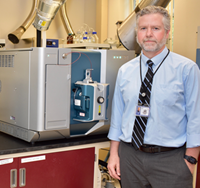 |
| Co-Project Director (CoPD) - Wade Elmer, Ph.D. Emeritus Scientist Department of Plant Pathology and Ecology The Connecticut Agricultural Experiment Station (CAES) 123 Huntington Street New Haven, CT 06511 203-974-8503 Wade.Elmer@ct.gov |
 |
|
CoPD - Howard Fairbrother, Ph.D. Professor |
 |
|
Jaya Borgatta, Ph.D. |
 |
|
JHU Graduate (Ph.D.) Student Leslie SigmonDepartment of Chemistry Johns Hopkins University (JHU) New Chemistry Building 216 3400 N. Charles Street, Baltimore, MD 21218 |
 |
Other Team Members: |
|
|
Christian Dimkpa, Ph.D. Head and Chief Scientist Department of Analytical Chemistry The Connecticut Agricultural Experiment Station 123 Huntington Street New Haven, CT 06511
Dr. Dimkpa’s research within the Department of Analytical Chemistry focuses on the fate and effects of engineered nanomaterials in agricultural plants, and the use of nanoscale nutrients to suppress crop diseases. One of the main themes of our research is on designing ways to minimize agrochemical inputs without sacrificing yield through the use of nanoscale nutrients. For instance, work on phosphorus (P) that is synergistic to the current USDA project involves formulation of P forms with biopolymers such as chitosan and/or the incorporation of micronutrients to regulate P availability to plants as described below.
|
 |
| Ishaq Adisa, Ph.D.
Post-doctoral Scientist Department of Analytical Chemistry The Connecticut Agricultural Experiment Station 123 Huntington Street New Haven, CT 06511 |
|
|
Mr. Craig Musante
Assistant Scientist I Department of Analytical Chemistry The Connecticut Agricultural Experiment Station 123 Huntington Street New Haven, CT 06511 203-974-8454 |
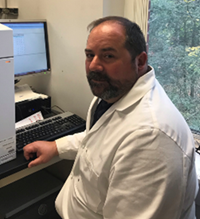 |
International Collaborators: |
|
| Daohui Lin, Ph.D./Prof. Department of Environmental Science Zhejiang University Hangzhou 310058, China Email: lindaohui@zju.edu.cn https://person.zju.edu.cn/en/0098366 Dr. Daohui Lin is a professor in the Department of Environmental Science, Zhejiang University, China. He obtained his Ph.D. in environmental science from Zhejiang University in 2005, M.S. in environmental science from Beijing Normal University in 1998, and B.S. in geography from Hangzhou University in 1995. He worked as a visiting scholar (2006-2008) at University of Massachusetts at Amherst. His research area is environmental science, focusing on environmental behavior and ecological effect of contaminants, especially of engineered nanomaterials. He has published about 170 research papers. He is a recipient of the National Natural Science Fund of China for Distinguished Young Scholars and is a project coordinator of the National Key Research and Development Program of China. He currently serves as editorial board members of Science of the Total Environment, Environmental Pollution, and Ecotoxicology and Environmental Safety. |
 |
| Prof. Melanie Kah Science Centre, Building 302.471 23 Symonds Street The University of Auckland Private Bag 92019 Auckland, New Zealand Email: melanie.kah@auckland.ac.nz My research is focused on the release, fate, effects and remediation of contaminants in the environment. I have worked with the whole spectrum of substances that are released as a result of human activities including pesticides, polymers, PAHs, PFASs, pharmaceuticals, metals and nanoparticles. Projects can involve desk-based, laboratory and field experiments, and aim at generating solid scientific bases to improve the management of our environment. I am particularly interested in elucidating the processes occurring at solid interfaces (e.g. sorption, degradation, uptake by organisms), and understand how they are influenced by environmental factors and the contaminant properties. My recent research on the ecological risk assessment of nanopesticides is a good illustration of the multidisciplinary approach applied in my group over the last years. |
|
| Helmi Hamdi, Dr. Agr. Eng. Habil Food-Energy-Waste-Sustainability (FEWS) Program Center for Sustainable Development College of Arts and Sciences Qatar University, Doha, Qatar Email: hhamdi@qu.edu.qa Phone: +974 44037574 Food-Energy-Waste-Sustainability Program (FEWS) Center for Sustainable Development, Qatar University |
 |
USDA Grant: Project Summary
PD- Jason C. White, The Connecticut Agricultural Experiment Station (CAES); Co-PD- David Howard Fairbrother, Johns Hopkins University (JHU); Co-PD- Wade Elmer, CAES
This is a Food and Agriculture Science Enhancement (FASE) Strengthening Standard Grant submitted to the USDA AFRI Foundational Program’s Agriculture Systems and Technology Program Area; Priority Code A1511 “Nanotechnology for Agricultural and Food Systems”
By 2050, the global population will exceed 9 billion, making maintaining global food security one of the most significant challenges we face as a species. Food production will need to increase by 70% but importantly, year-over-year-yield increases for many crops have been declining. Additionally, the lack of sustainability of current agriculture will confound maintaining global food security. For example, the low efficiency of nutrient delivery (10-20%) is a significant constraint, wasting energy and water resources, and causing environmental damage as growers “over-apply” to adequately feed crops. Consequently, there has been great interest in nano-enabled approaches to increase both the efficiency and targeting of nutrient delivery in agriculture.
Phosphorus use will exceed 26, 000 Gg/year by 2050, although delivery efficiency is typically only 10-15%. In addition to being unsustainable, the excessive use of P is a threat to aquatic environments and human health. We have preliminary data demonstrating that a biodegradable polymer-nanoparticle composite containing phosphate nanoparticles promotes plant growth as effectively as traditional fertilizers while reducing P run off by 10-fold. Building on this, we will develop a suite of P-containing biodegradable polymer nanocomposites able to deliver nutritionally required amounts of P to different crops in a spatially and temporally precise fashion. Moreover, this P delivery will be achieved with significantly reduced input amounts and with dramatic reductions in environmentally damaging P run-off/leachate. The long-term goal of this project is to develop a safe and sustainable biopolymer-based nanofertilizer platform for macronutrient delivery in both field and urban agriculture scenarios. Our three objectives are:
Obj.1- Identify biodegradation rates and P leaching/retention characteristics of different P-containing biodegradable nanocomposites in different soils. This information will enable us test our hypothesis that P release rates are directly correlated with and controlled by polymer biodegradation and that this mechanistic relationship allows material tunability.
Obj.2- Determine the viability of P-containing biodegradable polymer nanocomposites to enhance growth of different crops while minimizing P run off in greenhouse-based plant studies.
Obj.3- Validate P-containing biodegradable polymer nanocomposite performance for a range of different crops at field scale.
Our approach will be to develop a suite of P-containing biodegradable polymer nanocomposites that release P at tunable rates in response to polymer biodegradation. Once material properties have been optimized, greenhouse and field trials will be conducted with crops of varying nutritional demands (lettuce, tomato, soybean, corn, wheat) to demonstrate tunable efficacy across species and soil conditions, as well as across multiple planting cycles. Although NP use in agriculture is increasing, delivery strategies that are precise and accurate both spatially and temporally remain elusive. Novel and tunable P delivery approaches such as those developed in this work have great potential to significantly improve nutrient utilization and facilitate efforts to maintain global food security. To support this work, we will establish a Center of Excellence that will deploy a unique combination of educational and dissemination strategies to engage a range of stakeholders in this project.
| Nanotechnology has great opportunities to improve plant agriculture. Nanopesticides might have a higher efficacy and help to prevent runoff to surface and ground water. Nanotechnology-based genetic engineering might offer tremendous advantages compared to classical techniques. Plants could be used as sensors to provide information about their nutritional or health status. Nanotechnology might be used to modify the soil microbiome or be used in soil conditioning, and nano-carrier bound fertilizers might be more efficient than conventional products. Nano-enabled coatings might improve seed quality"(Hoffman et al. 2020. Moving forward responsibly in nanotechnology enabled plant agriculture. Nature Food, 1, 416–425). |
|
|
| Effect of nanoparticle elements on crop disease (Servin et al. 2015. A review of the use of engineered nanomaterials to suppress plant disease and enhance crop yield. J. Nano. Res. DOI:10.1007/s11051-015-2907-7). |
|
|
| Technology readiness level (TRL) for proposed application areas or approaches for nano-enabled technologies that can benefit agriculture. The TRL was determined based on available data regarding the maturity of the technology including the scale at which the materials or approach has been applied, and the number of studies that provide evidence of efficacy, and the number of commercially available products. The technology performance level (TPL) was determined based on expert judgment regarding the potential magnitude of the impacts that each technology may potentially provide to improve the sustainability of agriculture. (Hoffman et al. 2020. Moving forward responsibly in nanotechnology enabled plant agriculture. Nature Food, 1, 416–425). |
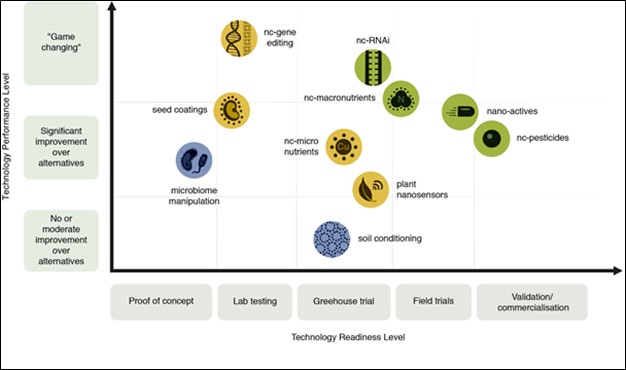 |
Core Research Team Information
|
Jason C. White, Ph.D.: Director, The Connecticut Agricultural Experiment Station Staff Biography: https://portal.ct.gov/CAES/ABOUT-CAES/Staff-Biographies/Jason-C-White Google Scholar: https://scholar.google.com/citations?user=AApdCWkAAAAJ&hl=en
Specifically, Dr. White serves as Project Director, overseeing all administrative activities of the USDA grant, including this Center of Excellence (CeNaPD). Dr. White also serves as quality assurance officer for the grant; the CAES Department of Analytical Chemistry, which Dr. White lead form 2009-2020, is ISO 17025 accredited (https://www.a2la.org/scopepdf/4133-01.pdf) for a food safety testing program (both human and animal food) with the CT Department of Consumer Protection, the CT Department of Agriculture and the US FDA. From a technical perspective, Dr. White, along with CoPD Elmer, will directly oversee the research activities of the Post-doctoral Associate hired on the project, Dr. Jaya Borgatta. In addition, Dr. White has four other Post-doctoral Associates and several international visitors in his laboratory; the collective expertise and select resources from that larger team will be frequently leveraged in this project. |
|
Wade Elmer, Ph.D.: Department of Plant Pathology and Ecology, The Connecticut Agricultural Experiment Station Staff Biography: http://www.ct.gov/caes/cwp/view.asp?a=2812&q=345106 Google Scholar: https://scholar.google.com/citations?user=xprubQcAAAAJ&hl=en
|
|
Howard Fairbrother, Ph.D.: Department of Chemistry, Johns Hopkins University JHU Biography: https://chemistry.jhu.edu/directory/howard-fairbrother/ Google Scholar: https://scholar.google.com/citations?user=rAWNwnEAAAAJ
Environmental Implications and Applications of Nanomaterials: We have a wide array of projects focused on exploring the environmental implications as well as the potential applications of engineered nanomaterials, particularly carbon nanotubes. Examples include: (1) exploring the release rates of carbon nanotubes and quantum dots from polymer nanocomposites, (2) photochemistry of carbon based nanomaterials, including carbon nanotubes, graphene and carbon dots, (3) impact of heteroatoms on the flame retarding properties of carbon nanotubes, (4) effect of carbon nanotube incorporation on biofilm formation and biodegradation properties of polymers. Many of these projects are highly collaborative and involve significant interactions with the Department of Geography and Environmental Engineering (DoGEE) at Johns Hopkins, researchers in the EPA funded center on the Life Cycle of Nanomaterials (LCNano), and the Center for Sustainable Nanotechnology (CSN) funded by the National Science Foundation. Experimental Approach: In all of our studies we use a wide array of experimental techniques, including Atomic Force Microscopy (AFM), X-ray Photoelectron Spectroscopy (XPS), Mass Spectrometry, Infrared Spectroscopy (IR) and UV-Vis Spectroscopy. We have also an array of electron spectroscopies, particularly Transmission Electron Microscopy (TEM) and Scanning Electron Microscopy (SEM) for materials characterization. The Fairbrother lab also maintains and operates the Johns Hopkins University University surface analytical laboratories which are available for use by researchers both within and outside the university. |
|
Jaya Borgatta, Ph.D. Google Scholar: https://scholar.google.com/citations?user=sC5dxp8AAAAJ
|
|
Leslie Sigmon: Department of Chemistry, Johns Hopkins University https://sites.krieger.jhu.edu/fairbrother-lab/
|
CeNaPD Publications:
- Sakhno, Y., Ma, C., White, J. C., Jaisi, D. (2021). Role of cation substitution in calcium phosphate based novel nanofertilizer impacts on lettuce (Lactuca sativa) yield. ACS Sust. Chem. Eng. Submitted.
- Sigmon, L. R., Adisa, I., Liu, B., Elmer, W. H., White, J. C., Dimkpa, C. O., Fairbrother, D. H. (2021). Biodegradable polymer nanocomposites provide effective delivery and reduced runoff of phosphorus during plant growth. ACS Agric. Sci. Technol. DOI: 10.1021/acsagscitech.1c00149
- Li, Q., Ma, C., White, J. C., Xing, B. (2021). Effects of phosphorus ensembled nanomaterials on nutrient uptake and distribution in Glycine max L. Agronomy 11:1086.
- Ma, C., Li, Q., Jia, W., Shang, H., Zhao, J., Hao, Y., Li, C., Tomko, M., Elmer, W., White, J. C., Xing, B. (2021). Role of nanoscale hydroxyapatite in disease suppression of Fusarium-infected tomato. Environ. Sci. Technol. https://doi.org/10.1021/acs.est.1c00901
Presentations and Posters:
Contact Dr. Jason C. White for additional information.
Other Nanotechnology-related Sites of Interest:
The NSF Center for Sustainable Nanotechnology https://susnano.wisc.edu/
Nanyang Technological University-Harvard University TH Chan School of Public Health Initiative for Sustainable Nanotechnology
Harvard University TH Chan School of Public Health Center for Nanotechnology and Nanotoxicology https://www.hsph.harvard.edu/nano/
Sustainable Nanotechnology Organization (SNO): http://www.susnano.org/
National Nanotechnology Initiative: http://www.nano.gov/
University of California Center for Environmental Implications of Nanotechnology (UC CEIN): http://www.cein.ucla.edu/new/
Duke University Center for the Environmental Implications of Nanotechnology (CEINT): http://ceint.duke.edu/
National Institute of Standards and Technology (NIST) Nanotechnology Portal: http://www.nist.gov/nanotechnology-portal.cfm
Sustainable Nanotechnologies Project: http://www.sun-fp7.eu/
US Department of Agriculture, National Institute of Food and Agriculture: https://nifa.usda.gov/topic/nanotechnology
Nanosystems Engineering Research Center for Nanotechnology-Enabled Water Treatment http://www.newtcenter.org/
National Institute of Health (NIH): https://www.nih.gov/research-training/nanotechnology-nih
US Food and Drug Administration (FDA): http://www.fda.gov/ScienceResearch/SpecialTopics/Nanotechnology/default.htm
US Environmental Protection Agency (EPA): https://www.epa.gov/chemical-research/research-nanomaterials
Arizona State University, Center for Nanotechnology in Society: http://cns.asu.edu/
Center for Food Safety: http://www.centerforfoodsafety.org/issues/682/nanotechnology#
CAES Center for Nanotechnology and Agricultural Pathogen Suppression (CeNAPS)
CAES Center for Nanoscale Sulfur Research (CENASR)
Related Publications of Interest:
- Deng, C., Wang, Y., Navarro, G., Sun, Y., Cota-Ruiz, K., Rawat, S., Tan, W., Peralta-Videa, J., Adisa, I., Dominguez, O. E., Hernandez-Viezcas, J. A., Niu, G., Li, C., White, J. C., Gardea-Torresdey, J. (2022). Copper oxide (CuO) nanoparticles affect yield, nutritional quality, and auxin associated gene expression in weedy and cultivated rice (Oryza sativa L.) grains. Sci. Tot. Environ., 810, 152260.
- Wu, T., Liao, X., Zou, Y., Yang, K., White, J. C., Lin, D. (2022). Fe-based nanomaterial transformation to amorphous Fe: Enhanced alfalfa rhizoremediation of PCBs-contaminated soil. J. Hazard. Mat., 127973.
- Shidore, T., Zuverza-Mena, N., White, J. C., da Silva, W. (2021). Nano-enabled delivery of RNA molecules for prolonged anti-viral protection in crop plants. ACS Applied Nano Materials. doi.org/10.1021/acsanm.1c03512.
- Chen, S., Yan, X., Tan, X., Zhang, W., Huang, Y., White, J. C., Zhao, L. (2021). Environmental implications of MoS2 nanosheets on rice and associated soil microbial communities. Chemosphere, 133004.
- Qu, H., Ma, C., Xing, W., Xue, L., Liu, H., White, J. C., Chen, G., Xing, B. 2021 Effects of copper oxide nanoparticles on Salix growth, soil enzyme activity and microbial community composition in a wetland mesocosm. J. Haz. Mat., 127676.
- Aytac, Z., Xu, J., Kumar, S., Eitzer, B. D., Xu, T., Vaze, N., Ng, K. W., White, J. C., Chan-Park, M. Luo, Y., Demokritou, P. (2021). Enzyme and relative humidity responsive antimicrobial fibers for active food packaging. ACS Appl. Mat. Int., 13(42):50298-50308
- White, J. C., Gardea-Torresdey, J. (2021). Nanoscale agrochemicals for crop health: A key line of Attack in the battle for global food security. Environ. Sci. Technol., 55(20), 13413–13416
- Meselhy, A. G., Sharma, S., Guo. Z., Singh, S., Yuan, H., Tripathi, R. D., Xing, B., Musante, C., White, J. C., Parkash-Dhankher, O. (2021). Nanoscale sulfur improves plant growth and reduces arsenic toxicity and accumulation in rice (Oryza sativa L.) Environ. Sci. Technol., doi.org/10.1021/acs.est.1c05495.
- Chen, S., Shi, N., Huang, M., Tan, X., Yan, X., Wang, A., Huang, Y., Ji, R., Zhou, D., Zhu, Y.-G., Keller, A. K., Gardea-Torresdey, J. L., White, J. C., Zhao, L. 2021. MoS2 nanosheets-cyanobacteria interaction: Reprogrammed carbon and nitrogen metabolism. ACS Nano. DOI: 10.1021/acsnano.1c05656.
- Marmiroli, M., Pagano, L., Rossi, R., De La Torre-Roche, R., Lepore, G. O., Ruotolo, R., Gariani, G., Bonanni, V., Pollstri, S., Puri, A., Gianoncelli, A., Aquilanti, G., d’Acapito, F., White, J. C., Marmiroli, N. (2021). Copper oxide nanomaterial fate in plant tissue: Nanoscale impacts on reproductive tissues.Environ. Sci. Technol. 55(15), 10769–10783
- Adeel, M., Shakoor, N., Shafiq, M., Pavlicek, A., Part, F., Zafiu, C., Raza, A., Zhang, P., Jilani, G., White, J. C., Ehmoser, E.-K., Lynch, I., Rui, Y. (2021). A critical review of the environmental impacts of manufactured nano-objects on earthworm species. Environ. Poll., 290:118041.
- Hou, J., Hu, C., White, J. C., Yang, K., Zhu, L., Lin, D. (2021). Nano-Zoo Interfacial Interaction as a Design Principle for Hybrid Soil Remediation Technology. ACS Nano. DOI: 10.1021/acsnano.1c05180
- Sigmon, L. R., Adisa, I., Liu, B., Elmer, W. H., White, J. C., Dimkpa, C. O., Fairbrother, D. H. (2021). Biodegradable polymer nanocomposites provide effective delivery and reduced runoff of phosphorus during plant growth. ACS Agric. Sci. Technol. DOI: 10.1021/acsagscitech.1c00149
- Cao, X., Pan, X., Couvillion, S., Zhang, T., Tamez, C., Bramer, L. M., White, J. C., Qian, W.-J., Thrall, B. D., Ng, K. W., Hu, X., Demokritou, P. (2021). Fate, cytotoxicity and cellular metabolomic impact of ingested carbon dots using simulated digestion and a triculture small intestinal epithelial model. NanoImpact, 23, 100349.
- Zhu, J., Wang, J., Shen, Y., Zhan, X., Li, A., White, J. C., Gardea-Torresdey, J., Xing, B. (2021). Role of charge and size in the translocation and distribution of zinc oxide particles in wheat cells. ACS Sust. Chem. Eng., 9(34), 11556-11564. https://doi.org/10.1021/acssuschemeng.1c04080
- Cao, X., Wang, C., Luo, X., Yu, L., White, J. C., Elmer, W., Parkash Dhankher, O., Wang, Z., Xing, B. (2021). Elemental sulfur nanoparticles enhance disease resistance in tomato. ACS Nano. doi.org/10.1021/acsnano.1c02917.
- Elmer, W., Zuverza-Mena, N., Triplett, L., Silady, R., Roberts, E., White, J. C. (2021). Foliar application of copper oxide nanoparticles suppress Fusarium wilt development on chrysanthemum. Environ. Sci. Technol. doi.org/10.1021/acs.est.1c02323.
- Shang, H., Ma, C., Li, C., Zhao, J., Elmer, W., White, J. C., Xing, B. (2021). CuO nanoparticle-embedded hydrogels to enhance nutrient supply and growth of lettuce infected with Fusarium oxysporum f. sp. lactucae. Environ. Sci. Technol. DOI: 10.1021/acs.est.1c00777.
- Wang, Y., Chen, S., Deng, C., Shi, X., Cota-Ruiz, K., White, J. C., Zhao, L., Gardea-Torresdey, J. L. (2021). Metabolomic analysis reveals dose-dependent alteration of maize (Zea mays L.) metabolites and mineral nutrient profiles upon exposure to zerovalent iron nanoparticles. NanoImpact, 100336.
- Adeel, M., Shakoor, N., White, J. C., Ahmed, M. A., Jilani, G., Rui, Y. (2021). Bioavailability and toxicity of nanoscale/bulk rare earth oxides in soil: Physiological and ultrastructural alterations in Eisenia fetida. Environ. Sci.: Nano, 8, 1654.
- Salinas, F., Astete, C. E., Waldvogel, J. H., Navarro, S., White, J. C., Elmer, W., Davis, J. A., Sabliov, C. M. (2021). Effects of engineered lignin-graft-PLGA and zein-based nanoparticles on soybean health. NanoImpact, 100329.
- Li, Q., Ma, C., White, J. C., Xing, B. (2021). Effects of phosphorus ensembled nanomaterials on nutrient uptake and distribution in Glycine max L. Agronomy, 11:1086.
- Ma, C., Li, Q., Jia, W., Shang, H., Zhao, J., Hao, Y., Li, C., Tomko, M., Elmer, W., White, J. C., Xing, B. (2021). Role of nanoscale hydroxyapatite in disease suppression of Fusarium-infected tomato. Environ. Sci. Technol. https://doi.org/10.1021/acs.est.1c00901.
- Noori, A., Bharath, L. P., White, J. C. (2021). Type-specific impacts of Ag on the protein profile of tomato (Lycopersicon esculentum). Int. J. Phytorem. In press.
- Adeel, M., Farooq, T., White, J. C., Gardea-Torresdey, J. L., Rui, Y. (2021). COVID‐19 and Nanoscience in the Developing World: Rapid Detection and Remediation in Wastewater. Nanomaterials, 11, 991.
- Li, C., Ma, C., Shang, H., White, J. C., McClements, D. J., Xing, B. (2021). Food-grade titanium dioxide particles decrease the bioaccessibility of iron released from spinach leaves in simulated human gastrointestinal tract. Environ. Sci.: Nano., 8, 1269-1282.
- Ma, C., Hao, Y., Zhao, J., Zuverza-Mena, N., Meselhy, A. G., Parkash Dhankher, O., Rui, Y., White, J. C., Xing, B. (2021). Graphitic carbon nitride (C3N4) reduces cadmium and arsenic phytotoxicity and accumulation in rice (Oryza sativa L.). Nanomaterials, 11(4), 839.
- Borgatta, J. B., Lochbaum, C. A., Elmer, W., White, J. C., Pedersen, J. A., Hamers, R. J. (2021). Biomolecular corona formation on CuO nanoparticles in plant xylem fluid. Environ. Sci.: Nano., 8, 1067-1080.
- Farooq, T., Adeel, M., He, Z., Umar, M., Shakoor, N., da Silva, W., Elmer, W. H., White, J. C., Rui, Y. (2021). Nanotechnology and plant viruses: A novel disease management approach for resistant pathogens. ACS Nano, 15(4), 6030–6037.
- Kang, H., Elmer, W., Shen, Y., Asunción, P. B., Zuverza-Mena, N., Ma, C., White, J. C., Haynes, C. L. (2021). Silica nanoparticle dissolution rate controls the suppression of Fusarium wilt of watermelon (Citrullus lanatus). Environ. Sci. Technol., 5(20), 13513–13522.
- Wu, T., Liu, Y., Yang, K., Zhu, L., White, J. C., Lin, D. (2021). Synergistic remediation of PCB-contaminated soil with nanoparticulate zero-valent iron and alfalfa: Targeted changes in the root metabolite-dependent microbial community. Environ. Sci.: Nano, 8, 986-999.
- Li, C., Zhang, R., Ma, C., Shang, H., McClements, D. J., White, J. C., Xing, B. (2021). Food-grade titanium dioxide particles decrease the bioaccessibility of vitamin D3 under simulated gastrointestinal conditions. J. Agric. Food Chem., 69, 2855–2863.
- Rawat, S., Cota-Ruiz, K., Dou, H., Pullagurala, V., Zuverza-Mena, N., White, J. C., Niu, G., Sharma, N., Hernandez-Viezcas, J., Peralta-Videa, J., Gardea-Torresdey, J. (2021). Soil weathered CuO nanoparticles compromise foliar health and pigment production in spinach (Spinacia oleracea). Environ. Sci. Technol. doi.org/10.1021/acs.est.0c06548.
- Cerbu, C., Kah, M., White, J. C., Astete, C. E., Sabliov, C. (2021). Fate of biodegradable engineered nanoparticles used in veterinary medicine as delivery systems from a One Health perspective. Molecules, 26(3), 523.
- Elmer, W., De La Torre-Roche, R., Zuverza-Mena, N., Dimkpa, C., Gardea-Torresey, J., White, J. C. (2021). Influence of single and combined mixtures of metal oxide nanoparticles on eggplant growth, yield, and Verticillium wilt severity. Plant Disease, 105, 1153-1161.
- Liu, Y., Wu, T., White, J. C., Lin, D. (2021). A new strategy using nZVI to simultaneously promote remediation and safe crop production in contaminated soil. Nature Nanotechnol., 16, 197–205.
- Song, C., Cheng, X., White, J. C., Zhang, H., Zhao, L., He, J., Zhu, Y., Wang, Y. (2020). Metabolic profile and physiological response of cucumber exposed to engineered MoS2 and TiO2 nanoparticles. NanoImpact, 20, 100271.
- Zhu, J., Li, J., Shen, Y., Liu, S., Zeng, N., Zhan, X., White, J. C., Gardea-Torresdey, J., Xing, B. (2020). Mechanism of ZnO nanoparticle entry into wheat seedling leaves. Environ. Sci.: Nano., 7, 3901.
- Jia, W., Ma, C., Yin, M., Sun, H., Zhao, Q., White, J. C., Wang, C., Xing, B. (2020). Accumulation of phenanthrene and its metabolites in Lactuca sativa as affected by magnetic carbon nanotubes and dissolved humic acids. Environ. Sci: Nano, 7(12), 3759-3772. https://doi.org/10.1039/D0EN00932F
- De La Torre-Roche, R., Cantu, J., Tamez, C., Zuverza-Mena, N., Hamdi, H., Elmer, W., Gardea-Torresdey, J., White, J. C. (2020). Seed biofortification by engineered nanomaterials: A pathway to alleviate malnutrition? J. Agric. Food Chem., 68, 12189-12202.
- Ma, C., Borgatta, J., Hudson, B. G., Tamijani, A. A., De La Torre-Roche, R., Zuverza-Mena, N., Shen, Y., Elmer, W. H., Xing, B., Mason, S. E., Hamers, R. J., White, J. C. (2020). Advanced material modulation of plant nutritional and phytohormone status suppresses soybean sudden death syndrome (SDS) and increases yield. Nature Nanotechnol. 15, 1033–1042Adeel, M., Farooq, T., White, J. C., Hao, Y., Rui, Y. (2021). Carbon-based nanomaterials suppress tobacco mosaic virus (TMV) infection and induce resistance in Nicotiana benthamiana. J. Hazard. Mat., 404, 124167.
- Shen, Y., Borgatta, J., Ma, C., Elmer, C., Hamers, R. J., White, J. C. (2020). Copper nanomaterial morphology and composition control foliar transfer through the cuticle and mediate resistance to root fungal disease in tomato (Solanum lycopersicum). J. Agric. Food Chem. doi.org/10.1021/acs.jafc.0c04546
- Elmer, W., De La Torre-Roche, R., Zuverza-Mena, N., Dimkpa, C., Gardea-Torresey, J., White, J. C. (2020). Influence of single and combined mixtures of metal oxide nanoparticles on eggplant growth, yield, and Verticillium wilt severity. Plant Disease. DOI:10.1094/pdis-07-20-1636-re.
- Liu, Y., Wu, T., White, J. C., Lin, D. (2020). A new strategy using nZVI to simultaneously promote remediation and safe crop production in contaminated soil. Nature Nanotechnol. In press.
- Aytac, Z., Huang, R., Vaze, N., Xu, T., Krol, W. J., Eitzer, B. D., White, J. C., Zhang, Z., Bousfield, D. W., Chan-Park, M. B., Parker, K. K., Demokritou, P. (2020). Biodegradable electrospun zein nanofibers for enhancing food safety and quality. ACS Sus. Chem. Eng. In press.
- Shang, H., Ma, C., Li, C., White, J. C., Chefetz, B., Polubesova, T., Xing, B. (2020). Copper sulfide nanoparticles suppress Gibberella fujikuroi infection in Oryza sativa seeds by multiple mechanisms: contact-mortality, nutritional modulation and phytohormone regulation. Environ. Sci.: Nano, 7, 2632-2643. https://doi.org/10.1039/D0EN00535E
- Sillen, W. M. A., Thijs, S., Abbamondi, G. R., De La Torre-Roche, R., Weyens, N., White, J. C., Vangronsveld, J. (2020). Nanoparticle treatment of maize analyzed through the metatranscriptome: Compromised nitrogen cycling, possible phytopathogen selection, and plant hormesis. Microbiome, 8, 127.
- An, J., Hu, P., Li, F., Wu, H., Shen, Y., White, J. C., Tian, X., Li, Z., Giraldo, J. P. (2020). Molecular mechanisms of plant salinity stress tolerance improvement by seed priming with cerium oxide nanoparticles. Environ. Sci: Nano. https://doi.org/10.1039/D0EN00387E.
- Xu, T., Ma, C., Aytac, A., Hu, X., Ng, K. W., White, J. C., Demokritou, P. (2020). Enhancing agrichemical delivery and seedling development with biodegradable, tunable, biopolymer-based nanofiber seed coatings. ACS Sus. Chem. Eng., 8(25), 9537–9548.
- Hofmann, T., Lowry, G., Ghoshal, S., Tufenkji, N., Brambilla, D., Dutcher, J., Gilbertson, L., Giraldo, J. P., Kinsella, M., del Capio Landry, M., Lovell, W., Naccache, R., Paret, M., Pederson, J., Unrine, J., White, J. C., Wilkinson, K. (2020). Moving forward responsibly in nanotechnology enabled plant agriculture. Nature Food, 1, 416–425.
- Hao, Y., Ma, C., White, J. C., Adeel, M., Jiang, R., Zhao, Z., Rao, Y., Rui, Y., Xing, B. (2020). Carbon-based nanomaterials alter the composition of the fungal endophyte community in rice (Oryza sativa). Environ. Sci.: Nano., 7, 2047-2060.
- Ma, C., Liu, H., Chen, G., Zhao, Q., Guo, H., Minocha, R., Long, S., Tang, Y., Saad, E. M., De La Torre-Roche, R., White, J. C., Parkash Dhankher, O., Xing, B. (2020). Dual roles of glutathione in silver nanoparticle detoxification and enhancement of nitrogen assimilation in soybean (Glycine max L.). Environ. Sci.: Nano. 7, 1954-1966.
- Dimkpa, C. O., Andrews, J., Sanabria, J., Singh, U., Elmer, W. H., Gardea-Torresdey, J. L., White, J. C. (2020). Interactive effects of drought, organic matter, and zinc oxide nanoscale and bulk particles on wheat performance and grain nutrient accumulation. Sci. Total Environ., 722, 137808. https://doi.org/10.1016/j.scitotenv.2020.137808
- Zhang, P., Guo, Z., Zhang, Z., Fu, H., White, J. C., Lynch, I. (2020). Nanomaterial transformation in plants: Implications for food safety and application in agriculture. Small https://doi.org/10.1002/smll.202000705.
- Wang, A., Jin, Q., Miao, A., White, J. C., Gardea-Torresey, J. L., Ji, R., Zhao, L. (2020). High-throughput screening for engineered nanoparticles that enhance photosynthesis using mesophyll protoplasts. J. Agric. Food Chem., 68(11), 3382-3389.
- Zhang, H., Huang, M., Zhang, W., Gardea-Torresdey, J. L., White, J. C., Ji, R., Zhao, L. (2020). Silver nanoparticles alter soil microbial community compositions and metabolite profiles in unplanted and cucumber-planted soil. Environ. Sci. Technol. 54(6), 3334-3342.
- Dimkpa, C. O., Andrews, J., Fugice, J., Singh, U., Bindraban, P. S., Elmer, W. H., Gardea-Torresdey, J. L., White, J. C. (2020). Facile coating of urea with low-dose ZnO nanoparticles promotes wheat performance and enhances Zn uptake under drought stress. Front. Plant Sci., 11, 168.
- Adisa, I., Rawat, S., Pullagurala, V. L. R., Dimkpa, C. O., Elmer, W. H., White, J. C., Peralta-Videa, J. R., Gardea-Torresdey, J. L. (2020). Nutritional status of tomato (Solanum lycopersicum) fruit grown in Fusarium-infested soil: Impact of cerium oxide nanoparticles. J. Agric. Food Chem., 68, 1986-1997.
- Hu, J., Wu, X., Wu, F., Chen, W., White, J. C., Yang, Y., Wang, B., Xing, B., Tao, S., Wang, X. (2020). Potential application of titanium dioxide nanoparticles to improve the nutritional quality of coriander (Coriandrum sativum L.). J. Hazard. Mat., 389, 121837
- Peréz, C. D. P., De La Torre-Roche, R., Zuverza-Mena, N., Ma, C., Shen, Y., White, J. C., Ampélio Pozza, E., Pozza, A. A. A., Elmer, W. H. (2020). Metalloid and metal oxide nanoparticles suppress Sudden Death Syndrome of soybean. J. Ag. Food Chem., 68, 7-87.
- Liao, Y. Y., Strayer-Scherer, A., White, J. C., De La Torre-Roche, R., Ritchie, L., Colee, J., Vallad G. E., Freeman, J., Jones, J. B., Paret, M. L. (2019). Particle-size dependent bactericidal activity of magnesium oxide against Xanthomonas perforans and bacterial spot of tomato. Sci. Reports, 9, 18530.
- Buchman, J., Elmer, W., Ma, C., Landy, K., White, J. C., Haynes, C. (2019). Chitosan-coated mesoporous silica nanoparticle treatment of Citrullus lanatus (Watermelon): Enhanced fungal disease suppression and modulated expression of stress-related genes. ACS Sus. Chem. Eng., 7, 19649-19659.
- Bindraban, P. S., Franklin, F. A., White, J. C., Melse-Boonstra, A., Koele, N., Pandey, R., Dimkpa, C. O., Rodenburgh, J., Senthilkumar, K., Demokritou, P., Schmidt, S. (2020). Safeguarding human and planetary health demands a fertilizer sector transformation. Plants, People, Planet. doi.org/10.1002/ppp3.10098.
- Dimkpa, C. O., Singh, U., Bindraban, P. S., Elmer. W. H., Gardea-Torresdey, J. L., White, J. C. (2019). Zinc oxide nanoparticles alleviate drought-induced alterations in sorghum performance, nutrient acquisition, and grain fortification. Sci. Tot. Environ., 688, 926-934.
- Kah, M., Tufenkji, N., White, J. C. (2019). Nano-enabled strategies to enhance crop nutrition and protection. Nature Nano., 14, 532-540.
- Ma, C., Borgatta, J., De La Torre-Roche, R., Zuverza-Mena, N., White, J. C., Hamers, R. J., Elmer, W. E. (2019). Time-dependent transcriptional response of tomato (Solanum lycopersicum L.) to Cu nanoparticle exposure upon infection with Fusarium oxysporum f. sp. lycopersici. ACS Sust. Chem. Eng., 7, 10064-10074.
- Adisa, I., Pullagurala, V. L. R., Peralta-Videa, J. R., Dimkpa, C. O., Ma, C., Elmer, W. H., Gardea-Torresdey J. L., White, J. C. (2019). Recent advances in nano-enabled fertilizers and pesticides: A critical review of mechanisms of action. Environ. Sci.: Nano. DOI: 10.1039/C9EN00265K
- Zhao, L., Zhang, H., Chen, X., Li, H., Qu, X., White, J. C., Ji, R. 2019 Metabolomics reveal that engineered nanomaterial exposure in soil alters both soil rhizosphere metabolite profiles and maize metabolic pathways. Environ. Sci.: Nano. DOI: 10.1039/c9en00137a
- Dimkpa, C. O., Singh, U., Bindraban, P. S., Adisa, I. O., Elmer, W. H., Gardea-Torresdey, J. L., White, J. C. (2019). Addition-omission of zinc, copper, and boron nano and bulk oxide particles demonstrate element and size -specific response of soybean to micronutrients exposure. Sci. Tot. Environ., 665, 606-616.
- Hao, Y., Fang, P., Ma, C., White, J. C., Xiang, Z., Duan, P., Zhao, Z., Adeel, M., Ali, A., Yang, J., Li, D., Wang, H., Zhang, Z., Rui, Y., Xing, B. (2019). Engineered nanomaterials inhibit Podosphaera pannosa infection on rose leaves by regulating phytohormones. Environ. Res., 170, 1-6.
- Borgatta, J., Ma, C., Hudson-Smith, N., Elmer, W., Plaza Pére, C. D., De La Torre-Roche, R., Zuverza-Mena, N., Haynes, C. L., White, J. C., Hamers, R. J. (2018). Copper nanomaterials suppress root fungal disease in watermelon (Citrullus lanatus): Role of particle morphology, composition and dissolution behavior. ACS Sustain. Chem. Eng., 6(11), 14847–14856.
- Elmer, W. H., Ma, C., White, J. C. (2018). Nanoparticles for plant disease management. Curr. Op. Environ. Sci. Health, 6, 66-70.
- Guo, H., White, J. C., Wang, Z., Xing, B. (2018). Nano-enabled fertilizers to control the release and use efficiency of nutrients. Curr. Op. Environ. Sci. Health doi.org/10.1016/j.coesh.(2018).07.009
- Dimkpa, C. O., Singh, U., Bindraban, P.E., Elmer, W.E., Gardea-Torresdey, J., White, J. C. (2018). Exposure to weathered and fresh nanoparticle and ionic Zn in soil promotes grain yield and modulates nutrient acquisition in winter wheat (Triticum aestivum). J. Agric. Food Chem., 66(37), 9645-9656.
- White, J. C., Gardea-Torresdey, J. (2018). Nanotechnology and agriculture: The path to food security may be through the very small. Nature Nano., 13, 627:629.
- Dimkpa, C. O., Adisa, I. O., Elmer, W.E., Gardea-Torresdey, J. L., White, J. C. (2018). Effect of manganese nanoparticle exposure on nutrient acquisition in wheat. Agronomy, 8(9), 158 doi.org/10.3390/agronomy8090158.
- Elmer, W., White, J. C. (2018). The future of nanotechnology in plant pathology. Ann. Rev. Phytopath., 56, 111–133.
- Adisa, I., Pullagurala, V. L. R., Rawat, S., Hernandez-Viezcas, J. A., Dimkpa, C. O., Elmer, W. H., White, J. C., Peralta-Videa, J. R., Gardea-Torresdey, J. L. (2018). Role of cerium compounds in Fusarium wilt suppression and growth enhancement in tomato (Solanum lycopersicum). J. Agric. Food Chem., 66, 5959-5970.
- Liao, Y. Y., Strayer-Scherer, A., White, J. C., Mukherjee, A., De La Torre-Roche, R., Ritchie, L., Clark, D., Vallad G. E., Freeman, J., Jones, J. B., Paret, M. L. Nano-Magnesium oxide: A novel bactericide against copper-tolerant Xanthomonas perforans causing tomato bacterial spot. Phytopathol. J., 108(10), 146-147.
- Elmer, W., De La Torre-Roche, R., Pagano, L., Majumdar, S., Zuverza-Mena, N., Dimkpa, C., Gardea-Torresdey, J., White, J. C. (2018). Effect of foliarly applied nanoparticle CuO on Fusarium wilt of watermelon. Plant Disease, 102, 1394-1401.
- Hao, Y., Yuan, W., Ma, C., White, J. C., Zhang, Z., Hou, T., Dong, Y., Wang, Q., Wang, R., Xiang, Y., Xiang, Z., Dong, W., Xing, B., Zhou, T., Rui, Y. (2018). Engineered nanomaterials suppress Turnip mosaic virus infection in Nicotiana benthamiana. Environ. Sci.: Nano., 5, 1685-1693.
- Medina-Velo, I. A., Dominguez, O. E., Ochoa, L., Barrios, A. C., Hernández-Viezcas, J. A., White, J. C., Peralta-Videa, J. R., Gardea-Torresdey, J. L. (2017). Nutritional quality of bean seeds harvested from plants grown in different soils amended with coated and uncoated zinc oxide nanomaterials. Environ. Sci.: Nano., 4, 2336-2347.
- Dimkpa, C., White, J. C., Elmer, W., Gardea-Torresdey, J. (2017). Nanoparticle and ionic Zn promote nutrient loading of sorghum grain under low NPK fertilization. J. Agric. Food.
- Bhattacharyya, S., Bennett, J., Short, L., Theisen, T., Wichman, M. D., White, J. C., Wright, S. (2017). Nanotechnology in the water industry- Part 1:. Occurrence and risks. J AWWA, 109(11), 30-37.
- Bhattacharyya, S., Bennett, J., Short, L., Theisen, T., Wichman, M. D., White, J. C., Wright, S. (2017). Nanotechnology in the water industry- Part 2: Toxicology and analysis. J AWWA, 109(12), 45-53
- Li, J., Sang, H., Guo, H., Jung, G., Mukherjee, A., White, J. C., Xing, B. (2017). Antifungal mechanisms of ZnO and Ag nanoparticles to Sclerotinia homeocarpa. Nanotechnol., 28, 155101.
- Rodrigues, S., Dokoozlian, N., Hendren, C. O., Karn, B., Mauter, M., Sadik, O., Safarpour, M., Unrine, J., Viers, J., White, J. C., Wiesner, M. R., Lowry, G. V. (2017). Nanotechnology for sustainable food production: High value opportunities and scientific challenges. ES: Nano., 4, 767-781.
- Bradfield, S., Kumar, P., White, J. C., Ebbs, S. (2017). Zinc, copper, or cerium accumulation from metal oxide nanoparticles or ions in sweet potato: Yield effects and projected dietary intake from consumption. Plant Phys. Biochem. 110-128-137.
- Elmer, W., White, J. C. (2016). The use of metallic oxide nanoparticles to enhance growth of tomatoes and eggplants in disease infested soil or soilless medium. Environ. Sci: Nano., 3, 1072-1079.
- Ebbs, S., Bradfield, S., Kumar, P., White, J. C., Ma, X. (2016). Modeling dietary intake of zinc and copper from consumption of carrot (Daucus carota) exposed to metal oxide nanoparticles and metal ions. Front. Plant. Sci. 3, 114-126.
- Servin, A. D., White, J. C. (2016). Nanotechnology and agriculture: Next steps for understanding the balance between applications and implications. NanoImpact,1, 9-12.
- Mukherjee, A., Majumdar, S., Servin, A., Pagano, L., Parkash-Dhanker, O., White, J. C. (2016). Carbon nanomaterials in agriculture: A critical review. Front. Plant Sci., 7, 172.
- Ebbs, S., Bradfield, S., Kumar, P., White, J. C., Musante, C., Ma, X. (2016). Accumulation of zinc, copper, or cerium in carrot (Daucus carota) exposed to metal oxide nanoparticles. Environ. Sci.: Nano. 3, 114-126.
- Servin, A., Elmer, W., Mukherjee, A., De la Torre-Roche, R., Hamdi, H., White, J. C., Bindraban, P., Dimkpa, C. (2015). A review of the use of engineered nanomaterials to suppress plant disease and enhance crop yield. J. Nano. Res. DOI:10.1007/s11051-015-2907-7.
- Servin, A., Elmer, W., Mukherjee, A., De la Torre-Roche, R., Hamdi, H., White, J. C., Dimkpa, C. (2015). Nanoscale Micronutrients Suppress Disease. VFRC Report 2015/x. Virtual Fertilizer Research Center, Washington, D.C.


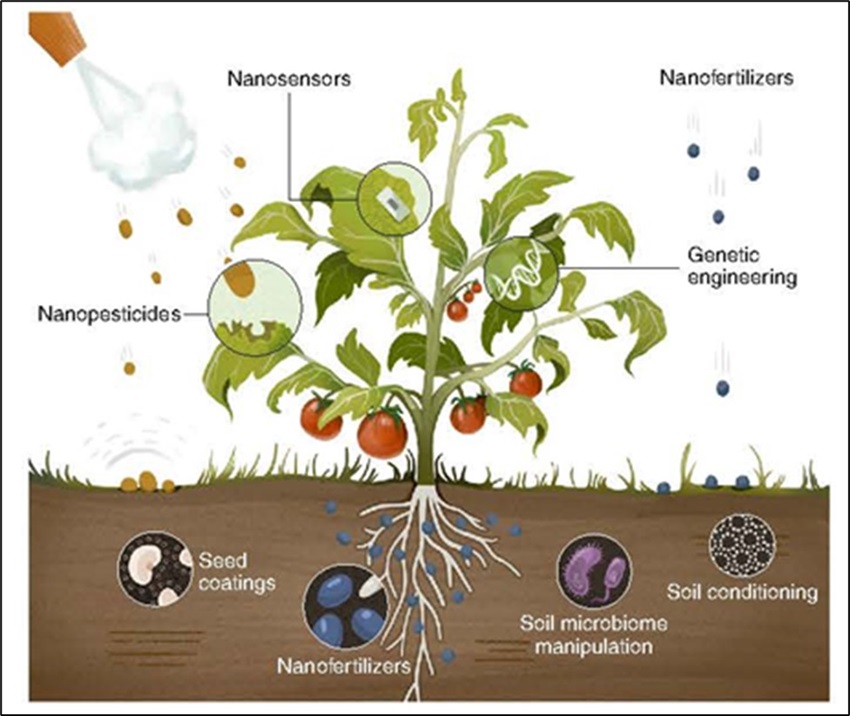
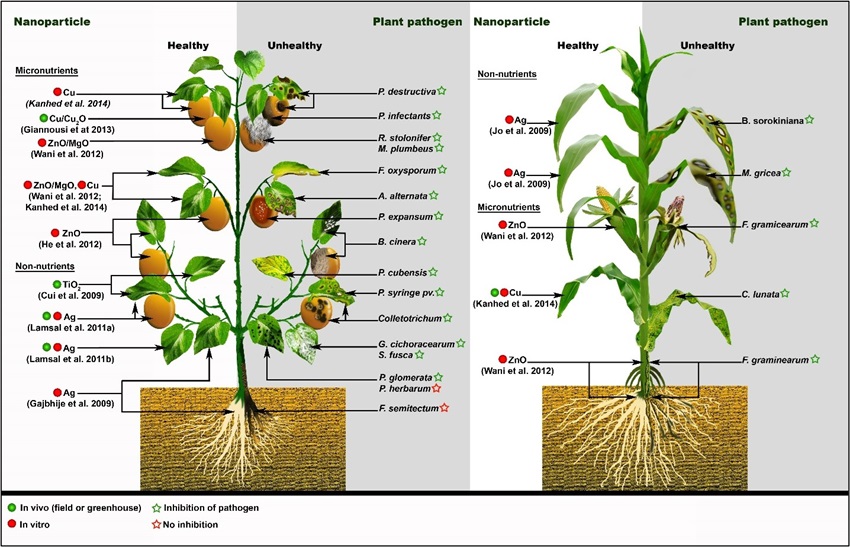
 Dr. Elmer serves as an Emeritus Scientist at The Connecticut Agricultural Experiment Station.He received his Ph.D in Plant Pathology from Michigan State University in 1985 and began his career at The Connecticut Agricultural Experiment Station in 1987. Understanding the mechanisms of disease suppression of ornamentals, vegetables, and field crops through manipulations of mineral nutrition has been his research focus for over 35 years. For the past 9 years, he has advanced innovative strategies for using metal oxide nanoparticles to improve plant health and increase yields. Dr. Elmer has edited four books, authored, or co-authored over 127 peer-reviewed papers, 26 book chapters, and written over 100 articles for trade magazines and symposia.
Dr. Elmer serves as an Emeritus Scientist at The Connecticut Agricultural Experiment Station.He received his Ph.D in Plant Pathology from Michigan State University in 1985 and began his career at The Connecticut Agricultural Experiment Station in 1987. Understanding the mechanisms of disease suppression of ornamentals, vegetables, and field crops through manipulations of mineral nutrition has been his research focus for over 35 years. For the past 9 years, he has advanced innovative strategies for using metal oxide nanoparticles to improve plant health and increase yields. Dr. Elmer has edited four books, authored, or co-authored over 127 peer-reviewed papers, 26 book chapters, and written over 100 articles for trade magazines and symposia. Research in the Fairbrother group involves aspects of environmental, analytical, physical and materials science and is focused on (i) understanding the mechanisms of depositing nanostructures, and (ii) exploring the environmental implications and applications of nanomaterials. Understanding Mechanisms of Depositing Nanostructures: One area of active research in our group is to develop a molecular level understanding of technologically important deposition processes are being used to create nanostructures. As part of this effort we are currently collaborating with researchers at the University of Florida and the University of Iceland to identify the surface chemistry and physics associated with the focused electron beam induced deposition (FEBID) of metallic nanostructures using organometallic precursors.
Research in the Fairbrother group involves aspects of environmental, analytical, physical and materials science and is focused on (i) understanding the mechanisms of depositing nanostructures, and (ii) exploring the environmental implications and applications of nanomaterials. Understanding Mechanisms of Depositing Nanostructures: One area of active research in our group is to develop a molecular level understanding of technologically important deposition processes are being used to create nanostructures. As part of this effort we are currently collaborating with researchers at the University of Florida and the University of Iceland to identify the surface chemistry and physics associated with the focused electron beam induced deposition (FEBID) of metallic nanostructures using organometallic precursors.